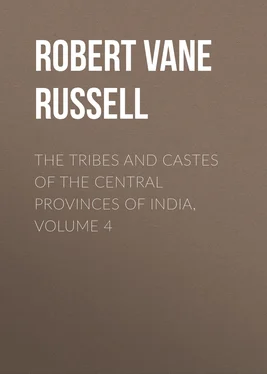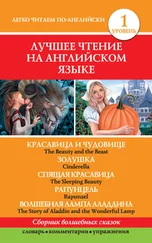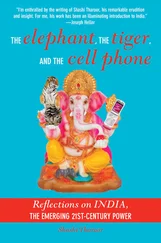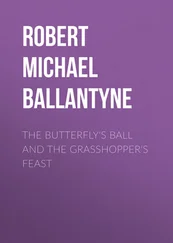Robert Vane Russell - The Tribes and Castes of the Central Provinces of India, Volume 4
Здесь есть возможность читать онлайн «Robert Vane Russell - The Tribes and Castes of the Central Provinces of India, Volume 4» — ознакомительный отрывок электронной книги совершенно бесплатно, а после прочтения отрывка купить полную версию. В некоторых случаях можно слушать аудио, скачать через торрент в формате fb2 и присутствует краткое содержание. Жанр: foreign_prose, История, foreign_edu, foreign_antique, на английском языке. Описание произведения, (предисловие) а так же отзывы посетителей доступны на портале библиотеки ЛибКат.
- Название:The Tribes and Castes of the Central Provinces of India, Volume 4
- Автор:
- Жанр:
- Год:неизвестен
- ISBN:нет данных
- Рейтинг книги:4 / 5. Голосов: 1
-
Избранное:Добавить в избранное
- Отзывы:
-
Ваша оценка:
- 80
- 1
- 2
- 3
- 4
- 5
The Tribes and Castes of the Central Provinces of India, Volume 4: краткое содержание, описание и аннотация
Предлагаем к чтению аннотацию, описание, краткое содержание или предисловие (зависит от того, что написал сам автор книги «The Tribes and Castes of the Central Provinces of India, Volume 4»). Если вы не нашли необходимую информацию о книге — напишите в комментариях, мы постараемся отыскать её.
The Tribes and Castes of the Central Provinces of India, Volume 4 — читать онлайн ознакомительный отрывок
Ниже представлен текст книги, разбитый по страницам. Система сохранения места последней прочитанной страницы, позволяет с удобством читать онлайн бесплатно книгу «The Tribes and Castes of the Central Provinces of India, Volume 4», без необходимости каждый раз заново искать на чём Вы остановились. Поставьте закладку, и сможете в любой момент перейти на страницу, на которой закончили чтение.
Интервал:
Закладка:
R. V. Russell
The Tribes and Castes of the Central Provinces of India, Volume 4
Pronunciation
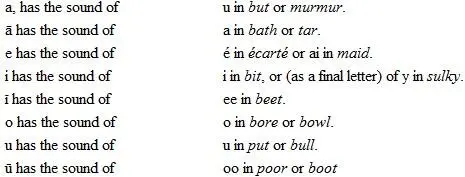
The plural of caste names and a few common Hindustāni words is formed by adding s in the English manner according to ordinary usage, though this is not, of course, the Hindustāni plural.
Note.—The rupee contains 16 annas, and an anna is of the same value as a penny. A pice is a quarter of an anna, or a farthing. Rs. 1–8 signifies one rupee and eight annas. A lakh is a hundred thousand, and a krore ten million.
Part II
Articles on Castes and Tribes
Kumhār—Yemkala
Vol. IV
Kumhār
1. Traditions of origin
Kumhār, Kumbhār.—The caste of potters, the name being derived from the Sanskrit kumbh , a water-pot. The Kumhārs numbered nearly 120,000 persons in the Central Provinces in 1911 and were most numerous in the northern and eastern or Hindustāni-speaking Districts, where earthen vessels have a greater vogue than in the south. The caste is of course an ancient one, vessels of earthenware having probably been in use at a very early period, and the old Hindu scriptures consequently give various accounts of its origin from mixed marriages between the four classical castes. “Concerning the traditional parentage of the caste,” Sir H. Risley writes, 1 1 Tribes and Castes of Bengal , art. Kumhār.
“there seems to be a wide difference of opinion among the recognised authorities on the subject. Thus the Brahma Vaivārtta Purāna says that the Kumbhakār or maker of water-jars ( kumbka ), is born of a Vaishya woman by a Brāhman father; the Parāsara Samhita makes the father a Mālākār (gardener) and the mother a Chamār; while the Parāsara Padhati holds that the ancestor of the caste was begotten of a Tili woman by a Pattikār or weaver of silk cloth.” Sir Monier Williams again, in his Sanskrit Dictionary, describes them as the offspring of a Kshatriya woman by a Brāhman. No importance can of course be attached to such statements as the above from the point of view of actual fact, but they are interesting as showing the view taken of the formation of castes by the old Brāhman writers, and also the position given to the Kumhār at the time when they wrote. This varies from a moderately respectable to a very humble one according to the different accounts of his lineage. The caste themselves have a legend of the usual Brāhmanical type: “In the Kritayuga, when Maheshwar (Siva) intended to marry the daughter of Hemvanta, the Devas and Asuras 2 2 Gods and demons.
assembled at Kailās (Heaven). Then a question arose as to who should furnish the vessels required for the ceremony, and one Kulālaka, a Brāhman, was ordered to make them. Then Kulālaka stood before the assembly with folded hands, and prayed that materials might be given to him for making the pots. So Vishnu gave his Sudarsana (discus) to be used as a wheel, and the mountain of Mandāra was fixed as a pivot beneath it to hold it up. The scraper was Adi Kūrma the tortoise, and a rain-cloud was used for the water-tub. So Kulālaka made the pots and gave them to Maheshwar for his marriage, and ever since his descendants have been known as Kumbhakār or maker of water-jars.”
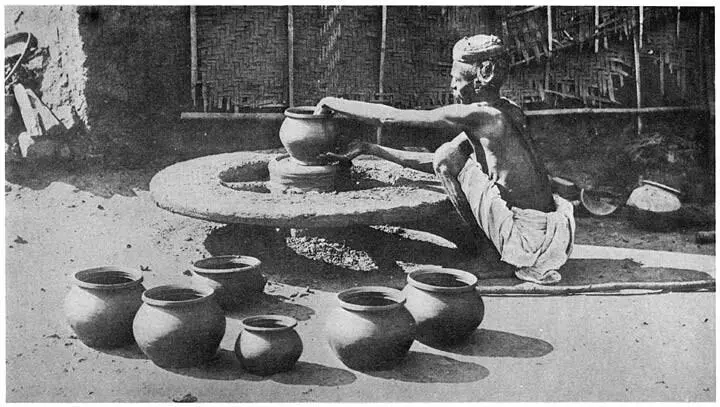
Potter and his wheel
2. Caste sub-divisions
The Kumhārs have a number of subcastes, many of which, as might be expected, are of the territorial type and indicate the different localities from which they migrated to the Central Provinces. Such are the Mālwi from Mālwa, the Telenga from the Telugu country in Hyderābād, the Pardeshi from northern India and the Marātha from the Marātha Districts. Other divisions are the Lingāyats who belong to the sect of this name, the Gadhewāl or Gadhere who make tiles and carry them about on donkeys ( gadha ), the Bardia who use bullocks for transport and the Sungaria who keep pigs ( suar ). Certain endogamous groups have arisen simply from differences in the method of working. Thus the Hāthgarhia 3 3 Hāth , hand and garhna to make or mould.
mould vessels with their hands only without using the wheel; the Goria 4 4 Gora , white or red, applied to Europeans.
make white or red pots only and not black ones; the Kurere mould their vessels on a stone slab revolving on a stick and not on a wheel; while the Chakere are Kumhārs who use the wheel ( chāk ) in localities where other Kumhārs do not use it. The Chhutakia and Rakhotia are illegitimate sections, being the offspring of kept women.
3. Social Customs
Girls are married at an early age when their parents can afford it, the matches being usually arranged at caste feasts. In Chānda parents who allow a daughter to become adolescent while still unwed are put out of caste, but elsewhere the rule is by no means so strict. The ceremony is of the normal type and a Brāhman usually officiates, but in Betūl it is performed by the Sawāsa or husband of the bride’s paternal aunt. After the wedding the couple are given kneaded flour to hold in their hands and snatch from each other as an emblem of their trade. In Mandla a bride price of Rs. 50 is paid.
The Kumhārs recognise divorce and the remarriage of widows. If an unmarried girl is detected in criminal intimacy with a member of the caste, she has to give a feast to the caste-fellows and pay a fine of Rs. 1–4 and five locks of her hair are also cut off by way of purification. The caste usually burn the dead, but the Lingāyat Kumhārs always bury them in accordance with the practice of their sect. They worship the ordinary Hindu deities and make an offering to the implements of their trade on the festival of Deothān Igāras. The village Brāhman serves as their priest. In Bālāghāt a Kumhār is put out of caste if a dead cat is found in his house. At the census of 1901 the Kumhār was ranked with the impure castes, but his status is not really so low. Sir D. Ibbetson said of him: “He is a true village menial; his social standing is very low, far below that of the Lohār and not much above the Chamār. His association with that impure beast, the donkey, the animal sacred to Sitala, the smallpox goddess, pollutes him and also his readiness to carry manure and sweepings.” As already seen there are in the Central Provinces Sungaria and Gadheria subcastes which keep donkeys and pigs, and these are regarded as impure. But in most Districts the Kumhār ranks not much below the Barhai and Lohār, that is in what I have designated the grade of village menials above the impure and below the cultivating castes. In Bengal the Kumhārs have a much higher status and Brāhmans will take water from their hands. But the gradation of caste in Bengal differs very greatly from that of other parts of India.
4. The Kumhār as a village menial
The Kumhār is not now paid regularly by dues from the cultivators like other village menials, as the ordinary system of sale has no doubt been found more convenient in his case. But he sometimes takes the soiled grass from the stalls of the cattle and gives pots free to the cultivator in exchange. On Akti day, at the beginning of the agricultural year, the village Kumhār of Saugor presents five pots with covers on them to each cultivator and receives 2½ lbs. of grain in exchange. One of these the tenant fills with water and presents to a Brāhman and the rest he reserves for his own purposes. On the occasion of a wedding also the bridegroom’s party take the bride to the Kumhārin’s house as part of the
Читать дальшеИнтервал:
Закладка:
Похожие книги на «The Tribes and Castes of the Central Provinces of India, Volume 4»
Представляем Вашему вниманию похожие книги на «The Tribes and Castes of the Central Provinces of India, Volume 4» списком для выбора. Мы отобрали схожую по названию и смыслу литературу в надежде предоставить читателям больше вариантов отыскать новые, интересные, ещё непрочитанные произведения.
Обсуждение, отзывы о книге «The Tribes and Castes of the Central Provinces of India, Volume 4» и просто собственные мнения читателей. Оставьте ваши комментарии, напишите, что Вы думаете о произведении, его смысле или главных героях. Укажите что конкретно понравилось, а что нет, и почему Вы так считаете.
